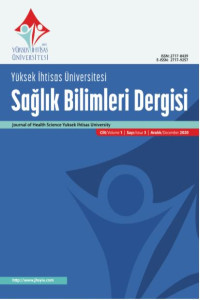MR defekografi ile pelvik taban yetmezliğinin değerlendirilmesi
MR defekografi, pelvik taban yetmezliği, spastik pelvik taban sendromu
Evaluation of pelvic floor dysfunction with magnetic resonance defecography
___
- 1. Haylen BT, de Ridder D, Freeman RM, Swift SE, Berghmans, B, Lee J, et al. An International Urogynecological Association (IUGA) / International Continence Society (ICS) joint report on the terminology for female pelvic floor dysfunction. Int Urogynecol J. 2010;21(1):5–26. https://doi.org/10.1007/s00192-009-0976-9
- 2. Remes-Troche JM, Rao SSC. Neurophysiological testing in anorectal disorders. Expert Rev Gastroenterol Hepatol. 2008;2(3):323–335. https://doi.org/10.1586/17474124.2.3.323
- 3. Silva ACA, Maglinte DD. Pelvic floor disorders: what’s the best test? Abdom Imaging. 2013;38(6):1391–1408. https://doi.org/10.1007/s00261-013-0039-z
- 4. Bitti GT, Argiolas GM, Ballicu N, Caddeo E, Cecconi M, Demurtas G, et al. Pelvic floor failure: MR imaging evaluation of anatomic and functional abnormalities. Radiographics. 2014;34(2):429–448. https://doi.org/10.1148/rg.342125050
- 5. García del Salto L, de Miguel Criado J, Aguilera del Hoyo LF, Velasco LG, Rivas PF, Paradela MM, et al. MR Imaging-based Assessment of the Female Pelvic Floor. Radiographics. 2014;34(5):1417–1439. https://doi.org/10.1148/rg.345140137
- 6. Law YM, Fielding JR. MRI of pelvic floor dysfunction. Am J Roentgenol.2008;191(6_supplement) :S45-S53. https://doi.org/10.2214/AJR.07.7096
- 7. Comiter CV, Vasavada SP, Barbaric ZL, Gousse AE, Raz S. Grading pelvic prolapse and pelvic floor relaxation using dynamic magnetic resonance imaging. Urology. 1999;54(3):454–457. https://doi.org/10.1016/S0090- 4295(99)00165-X
- 8. Lienemann A, Fischer T. Functional imaging of the pelvic floor. Eur J Radiol. 2003;47(2):117–122. https://doi.org/10.1016/S0720-048X(03)00164-5
- 9. Mortele KJ, Fairhurst J. Dynamic MR defecography of the posterior compartment: indications, techniques and MRI features. Eur J Radiol. 2007;61(3):462–472. https://doi.org/10.1016/j.ejrad.2006.11.020
- 10. El Sayed RF, Alt CD, Maccioni F, Meissnitzer M, Masselli G, Manganaro L, et al. Magnetic resonance imaging of pelvic floor dysfunction-joint recommendations of the ESUR and ESGAR Pelvic Floor Working Group. Eur Radiol. 2017;27(5):2067–2085. https://doi.org/10.1007/s00330-016-4471-7
- 11. Flusberg M, Sahni VA, Erturk SM, Mortele KJ. Dynamic MR defecography: assessment of the usefulness of the defecation phase. Am J Roentgenol. 2011;196(4):W394–W399. https://doi.org/10.2214/AJR.10.4445
- 12. Hetzer FH, Andreisek G, Tsagari C, Sahrbacher U, Weishaupt D. MR defecography in patients with fecal incontinence: imaging findings and their effect on surgical management. Radiology. 2006;240(2):449–457. https://doi.org/10.1148/radiol.2401050648
- 13. Bhan SN, Mnatzakanian GN, Nisenbaum R, Lee AB, Colak E. MRI for pelvic floor dysfunction: can the strain phase be eliminated? Abdom Radiol (NY). 2016;41(2):215–220. https://doi.org/10.1007/s00261-015-0577-7
- 14. Hassan HH, Elnekiedy AM, Elshazly WG, Naguib NN. Modified MR defecography without rectal filling in obstructed defecation syndrome: Initial experience. Eur J Radiol. 2016;85(9):1673–1681. https://doi.org/10.1016/j. ejrad.2016.06.014
- 15. Halligan S, Malouf A, Bartram CI, Marshall M, Hollings N, Kamm M. Predictive value of impaired evacuation at proctography in diagnosing anismus. Am J Roentgenol. 2001;177(3):633–636. https://doi.org/10.2214/ ajr.177.3.1770633
- 16. Jorge JM, Wexner SD, Ger GC, Nogueras J, Jagelman D. Cinedefecography and electromyography in the diagnosis of nonrelaxing puborectalis syndrome. Dis Colon Rectum. 1993;36(7):668–76. https://doi.org/10.1007/BF02238594
- 17. Kuijpers HC, Bleijenberg G. The spastic pelvic floor syndrome. A cause of constipation. Dis Colon Rectum. 1985;28(9):669–72. https://doi.org/10.1007/BF02553449
- 18. Reiner CS, Tutuian R, Solopova AE, Pohl D, Marincek B, Weishaupt D. MR defecography in patients with dyssynergic defecation: spectrum of imaging findings and diagnostic value. Br J Radiol. 2011;84(998):136–144. https://doi.org/10.1259/bjr/28989463
- ISSN: 2717-8439
- Başlangıç: 2020
- Yayıncı: Yüksek İhtisas Üniversitesi
AFETLERDE BEBEK BESLENMESİ VE BAKIMI
Kamile AKÇA, Aynur AYTEKİN ÖZDEMİR
Astaksantin'in Serebral İskemi-Reperfüzyonlu Sıçanlarda Doza Bağlı Etkisi
Bengi YEĞİN, Semih ÖZ, Dilek BURUKOĞLU DÖNMEZ, Hilmi ÖZDEN, Mehmet Cengiz ÜSTÜNER, Sibel CANBAZ KABAY, Ferruh YÜCEL
SPİNAL MUSKULER ATROFİSİ OLAN ÇOCUĞUN HEMŞİRELİK BAKIMI
Nihan KORKMAZ, Kadriye ŞAHİN, Serap BALCI
BİR GRUP ÜNİVERSİTE ÖĞRENCİSİNİN KORONAVİRÜS-19 FOBİSİ DÜZEYLERİNİN BELİRLENMESİ
Bircan KOLÇAK, Emel KÜLEKÇİ, Kübra AYMELEK HACIOSMANOĞLU, Fazilet TAMER
MR defekografi ile pelvik taban yetmezliğinin değerlendirilmesi
Habip Eser AKKAYA, Sena ÜNAL, Nuray ÜNSAL HALİLOĞLU, Ayşe ERDEN
Türkiye’de Sağlık Çalışanlarında İş Yaşam Kalitesi: Sistematik Derleme
İzole Sıçan Mesane Detrusor Kasında Omeprazolün Etkisi ve Bu Etkide Rac-1 Yolağının Rolü
